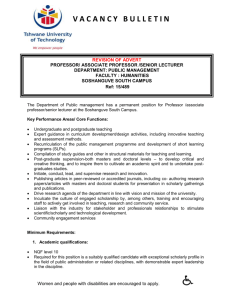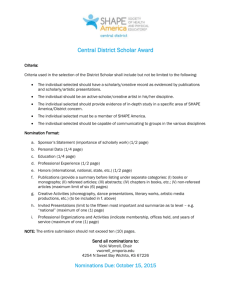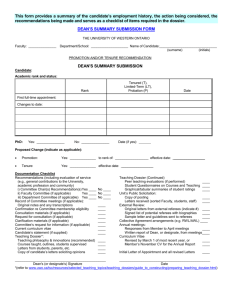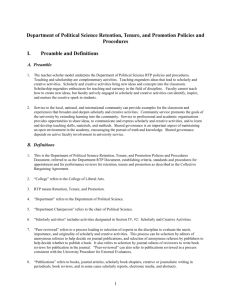Department of International Languages, Literatures
advertisement
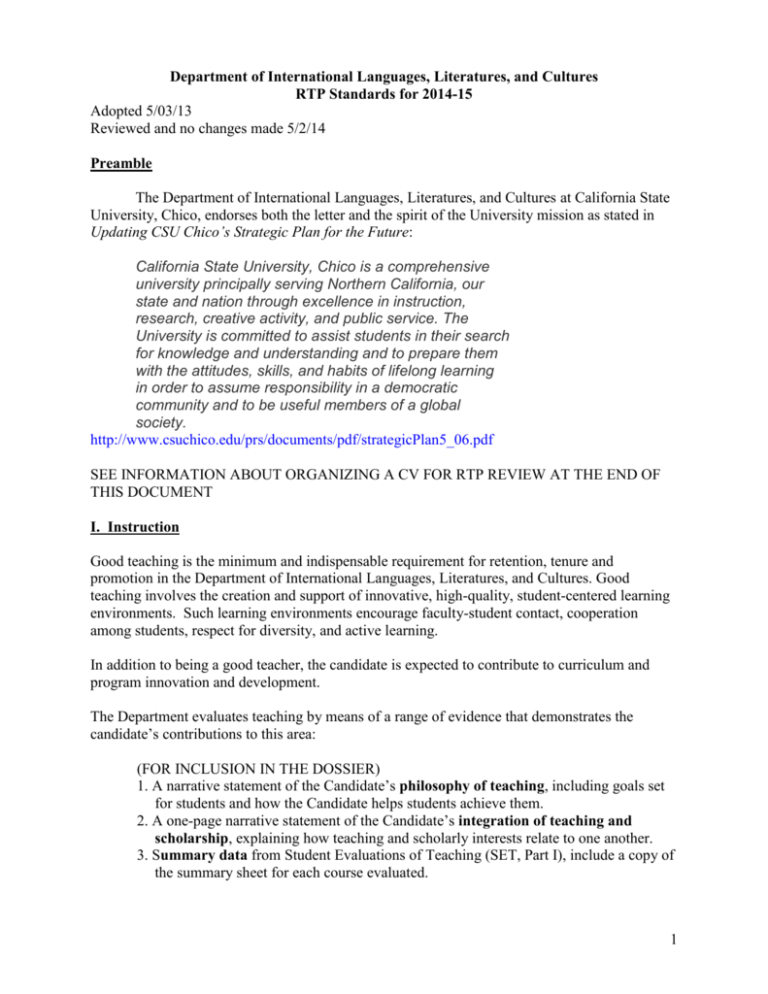
Department of International Languages, Literatures, and Cultures RTP Standards for 2014-15 Adopted 5/03/13 Reviewed and no changes made 5/2/14 Preamble The Department of International Languages, Literatures, and Cultures at California State University, Chico, endorses both the letter and the spirit of the University mission as stated in Updating CSU Chico’s Strategic Plan for the Future: California State University, Chico is a comprehensive university principally serving Northern California, our state and nation through excellence in instruction, research, creative activity, and public service. The University is committed to assist students in their search for knowledge and understanding and to prepare them with the attitudes, skills, and habits of lifelong learning in order to assume responsibility in a democratic community and to be useful members of a global society. http://www.csuchico.edu/prs/documents/pdf/strategicPlan5_06.pdf SEE INFORMATION ABOUT ORGANIZING A CV FOR RTP REVIEW AT THE END OF THIS DOCUMENT I. Instruction Good teaching is the minimum and indispensable requirement for retention, tenure and promotion in the Department of International Languages, Literatures, and Cultures. Good teaching involves the creation and support of innovative, high-quality, student-centered learning environments. Such learning environments encourage faculty-student contact, cooperation among students, respect for diversity, and active learning. In addition to being a good teacher, the candidate is expected to contribute to curriculum and program innovation and development. The Department evaluates teaching by means of a range of evidence that demonstrates the candidate’s contributions to this area: (FOR INCLUSION IN THE DOSSIER) 1. A narrative statement of the Candidate’s philosophy of teaching, including goals set for students and how the Candidate helps students achieve them. 2. A one-page narrative statement of the Candidate’s integration of teaching and scholarship, explaining how teaching and scholarly interests relate to one another. 3. Summary data from Student Evaluations of Teaching (SET, Part I), include a copy of the summary sheet for each course evaluated. 1 4. A narrative summary of student comments from Student Evaluations of Teaching (SET, Part II). Include only those courses taught since your last personnel evaluation. 5. A narrative summary of the peer evaluations, focusing on identified strengths and weaknesses in teaching, particularly those noted by multiple evaluators. 6. A narrative reflection on SETs and peer evaluations of teaching, indicating what the candidate has learned from the evaluation process and how these evaluations have or will result in changes to teaching. 7. A list of courses taught at CSU, Chico during the review period, including the following information: Course Number Course Title Year/Semester Taught New Course? Y/N New Syllabus? Y/N (SUPPLEMENTAL DATA) 8. The most recent syllabus for each course taught and any additional syllabi that demonstrate evolution of teaching. IMPORTANT: Syllabi should include a statement of course goals and objectives, a calendar of assignments and tests, and an indication of how the course meets disciplinary standards. 9. Examples of teaching materials created and other enhancements used and/or created (including digital or electronic, if applicable). 10. Evidence of contributions to interdisciplinary programs and General Education. 11. Evidence of contributions to the development of new courses or new contributions to the curriculum. 12. Evidence of prizes or honors for excellence in teaching. 13. Any other evidence the candidate deems essential to demonstrate the quality of her/his teaching in addition to #1 through 12 above. II. Professional Growth and Achievement Professional achievement at a comprehensive university may take many forms. It is critical to the viability of a university that all faculty maintain and demonstrate disciplinary currency either through scholarship in teaching and learning, critical inquiry and/or analysis, technological innovations and their applications to language instruction, or artistic creativity in the forms of prose, poetry or theater, or any other creative genre. However, any demonstration of scholarly currency shares the following traits: (a) originality, (b) verification and validation through impartial critical processes, (c) communication to others through available channels of publication. These forms of professional growth and achievement may include any or all of the following. Faculty may demonstrate scholarly competence in more than one area of growth and achievement: 1. Teaching and learning in their multiple interpretations and relationships; 2 2. The processes of discovery; 3. Artistic creativity, both according to established canons and the spirit of innovation; 4. Integration, application, popularization and dissemination of various forms of knowledge. The Department recognizes the diverse means by which the results of scholarly growth and development may be communicated. Candidates will provide the committee with the following summaries and documentation of research, publications, and professional achievement: (DOSSIER) 1. a) List of publications that the candidate has authored or co-authored, with a brief qualitative description of each. Such publications may include, but are not limited to: peer-reviewed monographs, dictionaries, textbooks, articles, entries in encyclopedic works, scholarly interviews, anthologies, translations, book reviews, and other contributions published in scholarly venues, whether in print, published electronically, or officially accepted for publication. b) List of publications of a creative nature, prose, poetry, theater, or other creative genre, which are relevant to the candidate’s area of specialization with a brief qualitative description. 2. List of public lectures, performances, openings, and/or shows. 3. List of grant and contract work. 4. List of peer-reviewed submissions delivered at professional meetings in the areas of language, literature, culture, technological innovations and their applications to language instruction, artistic creativity in the forms of prose, poetry or theater, or other areas of specialization. 5. List of projects, including, but not limited to, print, multimedia, electronic, and online media that contribute to the innovative delivery of foreign language instruction, including technological innovations and their applications to language instruction. 6. Summary list of participation in professional workshops, retreats, training, mentor programs, associations, electronic Listservs or bulletin boards, and other collaborative endeavors in one’s areas of scholarly specialization, technological innovations and their applications to language instruction, or artistic creativity in the forms of prose, poetry, theater, or other creative endeavors. 7. A list citing public and/or official recognition of meritorious achievement in one’s areas of scholarly specialization, technological innovations and their applications to language instruction, or artistic creativity in the forms of prose, poetry or theater. (SUPPLEMENTAL DATA) Supplemental data submitted to the department shall include evidence of the above activities (e.g., conference papers and programs, published articles, communication with publishers, etc). III. Service to the Department, College, University, Profession and/or Community The Department of International Languages, Literatures, and Cultures recognizes good service in these five areas as an integral part of the professional life of its faculty and therefore subject to review in the RTP process. These five service areas designated below are recognized by CSU Chico. The listed types of activities are representative of those that a productive and 3 contributing faculty member in the Department of International Languages, Literatures, and Cultures might undertake. However, a faculty member would not necessarily contribute in every area every year. (DOSSIER) Candidates shall provide a list of service activities, indicating any chair, supervisory, and mentoring positions held, and briefly (1-2 sentences) describing any personal contributions and accomplishments in committee service, where applicable. Recognized service includes: A. Program and department 1. Service on department committees; 2. Student major, minor, credential, and study abroad advising; 3. Participation in and support of student organizations and other student-centered activities; 4. Other contributions. B. College 1. Service on college committees. 2. Other contributions to the college. C. University 1. Service to International Programs; 2. Service on university committees; 3. Other contributions. D. Profession 1. Duties performed for or offices held in professional organizations; 2. Membership in professional associations; 3. Editorial services performed for professional associations and publishers; 4. Other contributions. E. 1. 2. 3. 4. Community outreach (including K-12) Outreach to schools; Pro bono translation and interpretation; Participation in community groups; Other contributions. (SUPPLEMENTAL DATA) Supplemental data shall include evidence that is representative of the candidate’s range of service activities and does not need to include documentation for every activity. Such evidence may include letters acknowledging participation in community outreach, proof of official role in professional or student organizations, examples of specific contributions to committee work, etc. 4 IV. Contributions to the Strategic Plan Refer to the university, college, department, and program strategic plans and statements of goals. (DOSSIER) All of the above categories already concern contributions to the Strategic Plan. If there are any other contributions not already mentioned, please include them here. ORGANIZING A CV FOR RTP REVIEW (RETENTION, TENURE, PROMOTION) (as opposed to your usual professional CV) 1. Organize everything chronologically with the year at the left (i.e. first) and giving the most recent information at the top. Therefore, as time goes by information from years past goes further and further down the list. 2. Create categories for each section (Instruction; Professional Growth and Achievement; Other Contributions) and subsections therein that would be entitled, e.g. Courses Created Since Last Review; Publications in Print Since Last Review, etc. This way of proceeding will help the department RTP committee best help you. 5




